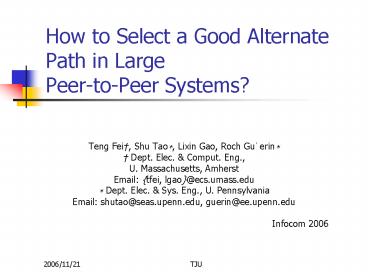How to Select a Good Alternate Path in Large PeertoPeer Systems - PowerPoint PPT Presentation
1 / 34
Title:
How to Select a Good Alternate Path in Large PeertoPeer Systems
Description:
2006/11/21. TJU. How to Select a Good Alternate Path in Large. Peer-to ... and UMN, Abilene, commercial provider networks (Cogent for Upenn, Wiltel for UMN) ... – PowerPoint PPT presentation
Number of Views:48
Avg rating:3.0/5.0
Title: How to Select a Good Alternate Path in Large PeertoPeer Systems
1
How to Select a Good Alternate Path in
LargePeer-to-Peer Systems?
- Teng Fei, Shu Tao, Lixin Gao, Roch Guerin
- Dept. Elec. Comput. Eng.,
- U. Massachusetts, Amherst
- Email tfei, lgao_at_ecs.umass.edu
- Dept. Elec. Sys. Eng., U. Pennsylvania
- Email shutao_at_seas.upenn.edu, guerin_at_ee.upenn.edu
-
Infocom 2006
2
Outline
- Introduction
- Related Work
- The Earliest-Divergence Rule
- Evaluation
- Measurement
- Conclusion
3
Introduction
- Background
- Performance degradation occur in Internet
- Application path switching is helpful when
multiple paths exist. - Peer-to-Peer network is an attractive platform
- Heterogeneous network
- Minimum infrastructure support requirement
4
Selecting an alternate path
- From thousands of IP address
- Choose one as relay
- Uncorrelated paths
5
Two challenges and approach
- There exist a large numbers of choices depends on
the target destination - The relay node may vary over time
- The approach is
- Most disjoint with the default path
- AS-level
6
Methodologies
- PlanetLab testbed
- Oregon Route Views and RIPE
- Two performance degradation metrics
- Delay degradation
- Loss path
7
Related Work
- RON and Tapestry correlation and may performance
degradation at the same time as the default path - A routing underlay dedicated to topology probing
- Use traceroute to obtain the IP-level path and
latency Information, to estimate the most
disjointness path - Random choose k and picking the best one
8
The Earliest-Divergence Rule
- Disjoint overlay path
- Overall probability of performance degradation
is - Pdegrad PX1X2 PX2PX1X2 (1)
- X1 denote the event path 1 experiences poor
performance - X2 denote the event path 2 experiences poor
performance - Monitor the performance variations on all
possible candidates simultaneously not a
scalable solution
9
- Using path disjointness as a selection criterion
may yield paths with significantly lower
performance correlation - i.e. PAB(x0,x1,,xn), PAO(y0,y1,,yn),
POB(z0,z1,,zn). - S as the overlap of PAB with PAO or POB,
minimizeS.
10
AS-level or IP-level ?
- IP-level
- The Traceroute routine can be challenging for
many source-destination pairs to obtain reliably
and accurately IP-level path information - The results of traceroute from the source node
only, is also difficult. - AS-level
- Also use traceroute for identifying the set of
ASes - Accurately infer the ASes even if return
incomplete IP-level path information - IP-level paths convert into AS-level paths
11
Comparison AS-level and IP-level
12
The Earliest-Divergence Rule
- In a system, N nodes, communicating node pairs
O(NN), relay nodes N-2,O(NN) comparisons - The earliest-divergence rule
- Select paths diverge at the earliest AS
- Among pre-select path set, select one
13
- PAB(x0,x1,,xi,,xn), PAO(x0,x1,,xi),
POB(xi,xi1,,xn) - Note x0,x1,,xn and z0,z1,,zj all represent ASes
- Link xi zj can be one of three types of inter-AS
links - Peering, customer-provider, or provider-customer
14
Selecting the Best Candidates
- Extend select nodes far from the direct path.
- Assume source node A knows the round-trip of
delay nodes selected by ED rule (denoted as DAO) - DAB denote the round-trip delay between source
node and destination node - Assume a upper bound denote as ß
- m (mlt10)
15
Evaluation
- Parallel paths diverging early have smaller
overall overlapping - Topology based study
- AS path data obtained from Oregon/RIPE and Planet
lab - Physically less overlapped paths have less
correlated performance - Measurement based study
- Active UDP probe using Planetlab nodes
16
(No Transcript)
17
Effect of Reducing Relay Node Numbers
-
PlanetLab
18
Effect of Reducing Relay Node Numbers
19
Effect of Selecting Disjoint Paths
- Retain good ones
20
Effect of Selecting Disjoint Paths
- Reject bad ones
21
Effect of Selecting Disjoint Paths
- Increases the likelihood of selecting good ones
22
Effect of Selecting Disjoint Paths
- Increases the likelihood of selecting good ones
23
Comparison with Random-4
24
Measurement
- Methodologies
- Use planetLab testbed test correlation
- Upenn and UMN, Abilene, commercial provider
networks (Cogent for Upenn, Wiltel for UMN)
25
Performance Correlation Metrics
- Two main performance parameters
- Delay variation degradation
- Di denotes the round-trip delay, mean ,
standard deviation ,k is a constant - Using window size L, a threshold a
26
Performance Correlation Metrics
- Two main performance parameters
- Loss variation degradation
- Samples, average loss rate certain time period
- Window size L, threshold ?
27
Comparison Delay with Loss
28
Performance Evaluation of EDR
- Better than random in most cases
- Significantly better in many cases
29
Comparison With Other Schemes
30
- Compare our scheme with general random-k scheme
31
Case
- 9 PlanetLab nodes as potential relays to build
alternate paths - 1default path, 9 alternate paths, 20ms, 48hours
- Assuming path switching is used between the
direct path and a selected overlay path - Focus on end-to-end losses, most unambiguous
- Compute average loss rate for all paths every 10
seconds(500 samples) - If average loss rate gt1, the path in a loss
period
32
Nodes information
33
Results
34
Conclusions
- Alternate path selection in a large P2P
environment - A good alternate path
- Most disjoint, AS-level
- ED rule to minimize overhead and ensure
scalability - Effectiveness, topology data and measurement
traces - Open question P2P system and underlying network
grow, how the proposed heuristic would change































